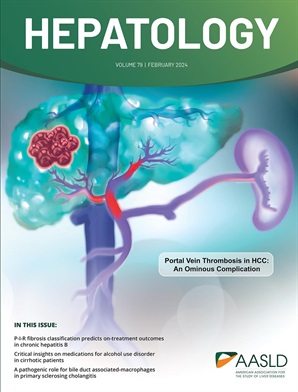Arid1a deficiency promotes hepatocyte hyperpolyploidy and drives intrahepatic cholangiocarcinoma in mice
IF 12.9
1区 医学
Q1 GASTROENTEROLOGY & HEPATOLOGY
引用次数: 0
Abstract
Background & Aims: Intrahepatic cholangiocarcinomas (ICCs) are aggressive liver tumors with high heterogeneity and limited therapeutic options. Although traditionally thought to arise from biliary cells, recent findings suggest that hepatocytes may also serve as a cellular origin for ICC. However, the mechanisms underlying hepatocyte malignant transformation and ICC initiation remain poorly understood. Approach and Results: We employed oncogene-driven and chemically induced ICC murine models, along with cellular models, to recapitulate the transformation of hepatocytes into ICC. Our findings demonstrate that mature hepatocytes undergo a significant hyperpolyploid state during ICC initiation. Hyperpolyploidy promotes aberrant cell division and chromosomal instability, accelerating hepatocyte transformation and ICC onset. Furthermore, we identified the chromatin remodeling factorArid1a缺乏促进小鼠肝细胞多倍体并驱动肝内胆管癌
背景,目的:肝内胆管癌(ICCs)是侵袭性肝脏肿瘤,具有高度异质性和有限的治疗选择。虽然传统上认为ICC起源于胆道细胞,但最近的研究结果表明,肝细胞也可能是ICC的细胞起源。然而,肝细胞恶性转化和ICC起始的机制仍然知之甚少。方法和结果:我们采用癌基因驱动和化学诱导的ICC小鼠模型,以及细胞模型,来概括肝细胞向ICC的转化。我们的研究结果表明,成熟肝细胞在ICC开始时经历了显著的超多倍体状态。高多倍体促进异常细胞分裂和染色体不稳定,加速肝细胞转化和ICC发病。此外,我们确定了染色质重塑因子Arid1a是超多倍体的关键抑制因子。Arid1a缺陷破坏中心体的有丝分裂机制,驱动超多倍体和ICC肿瘤发生。结论:肝细胞可通过超多倍体过程转化为ICC。这项研究为ICC的发病机制提供了新的见解,特别是在经常携带ARID1A突变的患者中。
本文章由计算机程序翻译,如有差异,请以英文原文为准。
求助全文
约1分钟内获得全文
求助全文
来源期刊

Hepatology
医学-胃肠肝病学
CiteScore
27.50
自引率
3.70%
发文量
609
审稿时长
1 months
期刊介绍:
HEPATOLOGY is recognized as the leading publication in the field of liver disease. It features original, peer-reviewed articles covering various aspects of liver structure, function, and disease. The journal's distinguished Editorial Board carefully selects the best articles each month, focusing on topics including immunology, chronic hepatitis, viral hepatitis, cirrhosis, genetic and metabolic liver diseases, liver cancer, and drug metabolism.
 求助内容:
求助内容: 应助结果提醒方式:
应助结果提醒方式:


